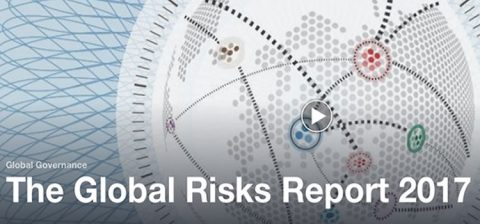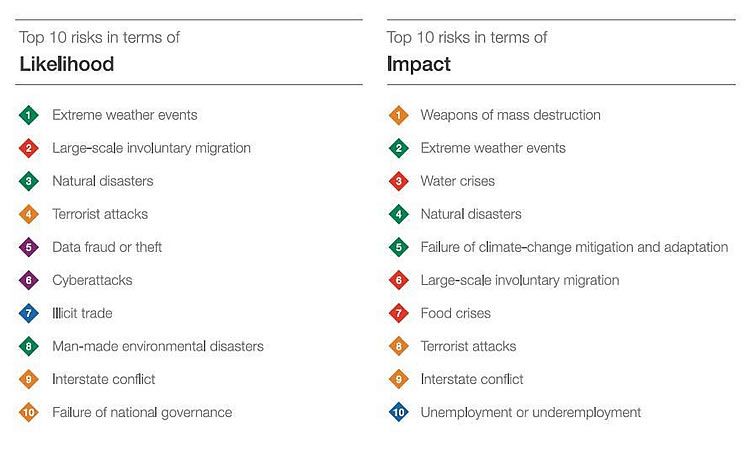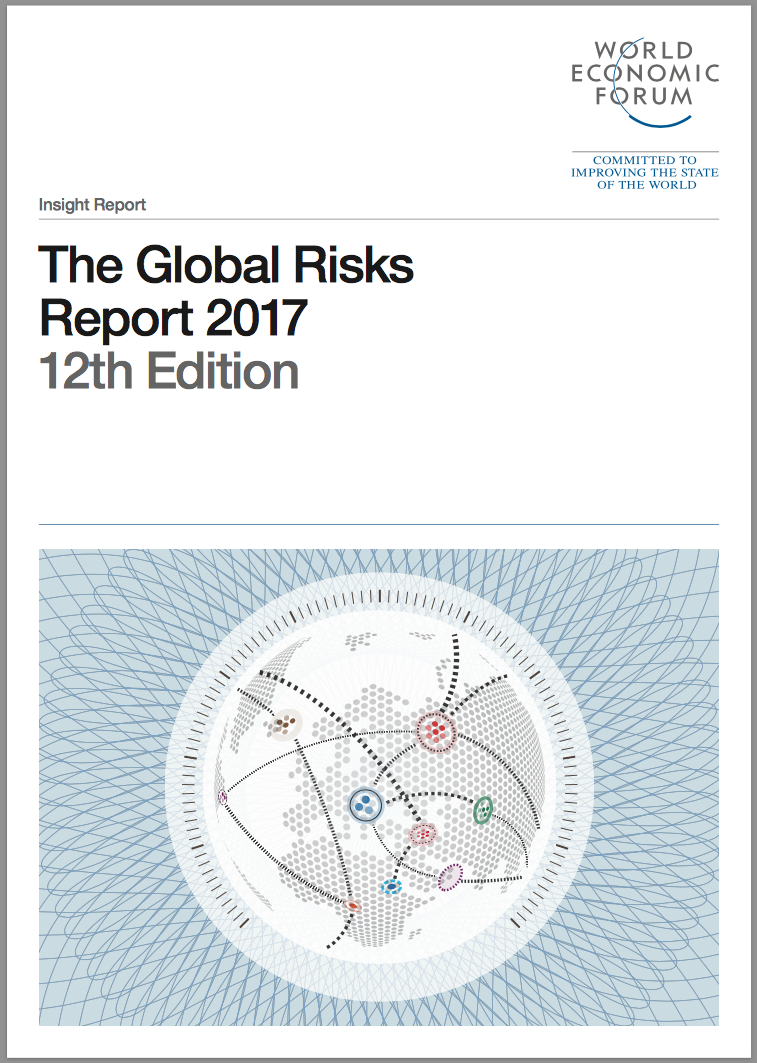
Klimaat grootste bedreiging voor de wereld
12 januari 2017 – Nee, niet de terroristische aanslagen en ook niet de massale migratie; de grootste bedreiging voor de wereld is het opwarmende klimaat. Dat concluderen 745 experts in het Global Risks Report 2017 van Het World Economic Forum in Davos.
Het World Economic Forum wordt dit jaar van 17 tot 20 januari gehouden, als altijd in het Zwitserse Davos. Gisteren publiceerde de organisatie het jaarlijkse Global Risk Report.
Jaarlijks komen in Davos een paar duizend regeringsleiders, CEO’s van multinationals en vertegenwoordigers van ngo’s bijeen voor een debat mondiale ontwikkelingen.
Het Global Risk Report 2017 heeft twee belangrijke lijstjes:

 Uit een bericht van het World Economic Forum
Uit een bericht van het World Economic Forum
‘(…)“Urgent action is needed among leaders to identify ways to overcome political or ideological differences and work together to solve critical challenges. The momentum of 2016 towards addressing climate change shows this is possible, and offers hope that collective action at the international level aimed at resetting other risks could also be achieved,” said Margareta Drzeniek-Hanouz, Head of Global Competitiveness and Risks, World Economic Forum.
How to address the world’s most pressing risks will be the subject of discussions at the World Economic Forum Annual Meeting 2017, which convenes 17-20 January under the theme Responsive and Responsible Leadership. (…)’
Positieve ontwikkelingen rond de klimaatdreiging
Het Global Risks Report signaleert rond het klimaatprobleem ook een aantal positieve ontwikkelingen:
‘(…) Further progress was made during 2016 in addressing climate and other environmental risks, reflecting firm international resolve on the transition to a low-carbon global economy and on building resilience to climate change:
- The Paris Agreement on climate change entered into force on 4 November 2016; it is now ratified by more than 110 countries;
- a strong signal of support for implementing the Paris Agreement was made by 196 governments, including China, at the Marrakesh Climate Conference in late November 2016;
- the International Civil Aviation Organisation agreed a “market-based measure” that will ensure no net growth in aviation emissions after 2020 – this is significant because international aviation, like shipping, falls outside the scope of the Paris Agreement; and
- also in October, parties to the Montreal Protocol on ozone-depleting substances agreed an important amendment that could help avoid an additional 0.5°C of warming by 2050 through reducing the use of hydro fluorocarbons (HFCs), which have an extremely high global warming potential.
The year 2016 also saw positive empirical evidence that the transition to a low-carbon economy is underway:
- Bloomberg New Energy Finance reported that global investment in renewable energy capacity in 2015 was US$266 billion, more than double the allocations to new coal and gas capacity; and
- the International Energy Agency (IEA) reported that the total generation capacity of renewable energy now exceeds coal-fired power plants for the first time, and for the past two years greenhouse gas emissions have been de-coupled from economic growth. (…)’
Maar het is niet genoeg
‘(…) However, the pace of change is not yet fast enough. Global greenhouse gas (GHG) emissions are growing, currently by about 52 billion tonnes of CO2 equivalent per year, even though the share from industrial and energy sources may be peaking as investment and innovation in green technology accelerates. The year 2016 is set to be the warmest on the instrumental record according to provisional analysis by the World Meteorological Organisation. It was the first time the global average temperature was 1 degree Celsius or more above the 1880–1999 average. According to the National Oceanic and Atmospheric Administration, each of the eight months from January through August 2016 were the warmest those months have been in the whole 137 year record.
The Emissions Gap Report 2016 from the United Nations Environment Programme (UNEP) shows that even if countries deliver on the commitments – known as Nationally Determined Contributions (NDCs) – that they made in Paris, the world will still warm by 3.0 to 3.2°C.
To keep global warming to within 2°C and limit the risk of dangerous climate change, the world will need to reduce emissions by 40% to 70% by 2050 and eliminate them altogether by 2100. While attention will be focused on China, the United States, the European Union, and India – which collectively comprise more than half of global emissions – all countries will need to ratchet up their action in order to limit warming to 2°C. (…)’
Registratie persconferentie Global Risks Report (lengte iets meer dan een uur)
Bronnen
World Economic Forum, rapport, 11 januari 2017: The Global Risks Report 2017 – 12th Edition (pdf, 72 pag.)
World Economic Forum, 11 januari 2017: Under-Employed, Under-Inclusive and Under Threat: the World in 2017
Website World Economic Forum



